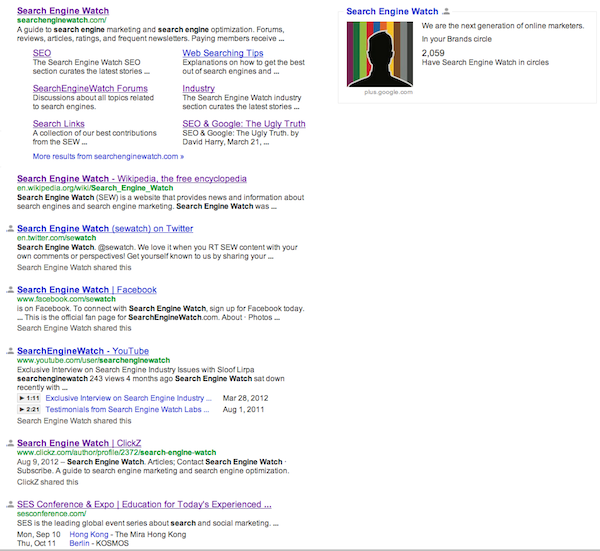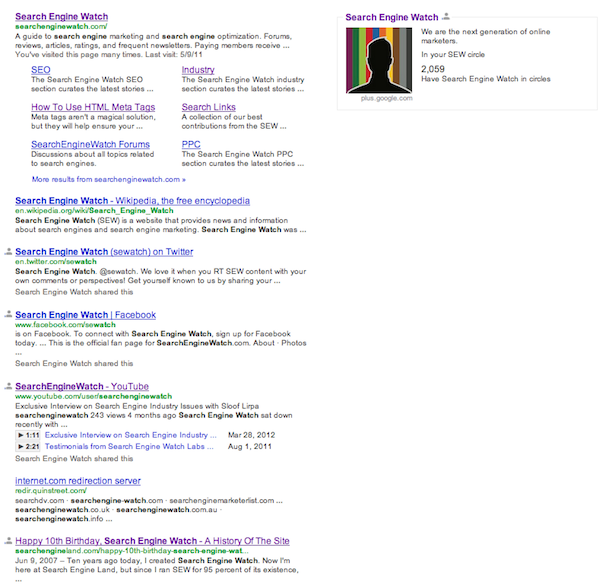A big change seems to be underway on Google, most likely designed to give brands more control of the search results associated with their brand names. Google is now showing three less results on searches for brand names (7, rather than 10).
Google: Now With 3 Less Results on ~18% of Searches
It appears the seven results are triggered on Google mainly when the No. 1 result has sitelinks – a cluster of additional “shortcut” links that point users to pages located on the same domain. Sitelinks are automatically shown for sites Google determines are useful to users (e.g., popular sites).
Google’s move to show less search results, in conjunction with an analysis by Dr. Pete at SEOmoz showing less domain diversity, has created the latest uproar in the search industry.
Essentially, Dr. Pete’s analysis of 1,000 unspecified queries showed a big spike (from 1-4 percent historically to 18 percent) in the number of SERPs now showing only seven results. Domain diversity in Google’s search results also took a hit since April, falling from 60 percent to 56 percent.
When a top ranked site doesn’t have sitelinks, Google continues to show the traditional 10 blue links, plus whatever other universal results are deemed relevant (news, images, videos, etc.). Which means the long tail is alive and well.
The official word from Google on all this:
We’re continuing to work out the best ways to show multiple results from a single site when it’s clear users are interested in that site. Separately, we’re also experimenting with varying the number of results per page, as we do periodically. Overall our goal is to provide the most relevant results for a given query as quickly as possible, whether it’s a wide variety of sources or navigation deep into a particular source. There’s always room for improvement, so we’re going to keep working on getting the mix right.
For brands, this is actually a reason to celebrate. And yes, this is actually good (or at worst neutral) for users.
Remember these three words: end user data. End user data is one of the strongest signals Google looks at to gauge search result quality and relevancy. As then-Google CEO Eric Schmidt told the New York Times in 2010:
“There is not a deliberate favoritism from a business perspective. There is a favoritism from what end users prefer, and we have ways to measure that.”
Many SEOs are bemoaning the death of search diversity, but is it your goal seriously to rank for “Apple” or “Best Buy” or “insert brand here” or an ambiguous terms that has nothing to do with your own website/brand? Google isn’t in the business of ranking irrelevant websites that result in failed searches for users. Just as you optimize your websites, Google is optimizing their search results.
Good Data In
What this change signals is the importance of verified data – or what we like to refer to as “good data”. For example, let’s look at the seven results returned for Search Engine Watch:

And here are my personalized results (SEW’s Google+ page moves to the right, and the SES Conference page moves into position seven):

What do you see in addition to SEW’s main domain: Wikipedia. Twitter. Facebook. YouTube. Google+. What do these sites all have? Good data. These sites provide verifiable data that Google can use to and establish connections and relationships between an entity, in this case, Search Engine Watch.
Verified data in this case seems to be any source that has to go through a fairly rigorous verification process. To own a brand name on a social network requires permissions that go beyond simply signing up with an email address and there are many other user signals Google could use to establish trust for that entity. Likewise, where we have seen iTunes and Google Play results appear, to get such a listing requires a brand to pass a much more rigorous authentication process, including billing details, contractual agreements and the like.
However, one result that doesn’t seem to fit is Quinstreet. We have a theory on why this one has surfaced.
If you go to that page, it returns a long list of websites, some of which our parent company Incisive Media owns, all of which were owned by former SEW owner Jupiter Media. Quinstreet seems to be part of internet.com, where many of these redirects are aimed.
Although we haven’t completely figured out what’s going on here, it seems to support the theory that Google is actually looking at multiple sources and trying to use as many verified data signals as it can to leverage brand results and surface domains that have similar signals (i.e., registrar data) and at one time shared a relationship.
These URLs are supposed to serve as redirects to Incisive Media sites, so this further seems to show how Google is trying to discern relationships – perhaps via type-in traffic – as Google has decided to show this result as relevant to people searching for Search Engine Watch – even though it is ultimately a useless result. It does not seem far-fetched that since Google Chrome’s address bar doubles as a search box, Google maybe trying to disambiguate a number of queries.
One other noteworthy addition here is personalization. While I am seeing the above results, SEW Director Jonathan Allen is seeing a slightly different set of personalized results:

This is an important reminder that, just as geolocation is a growing factor in the results Google serves, Google is looking at end user data to serve some of the results you’re seeing.
While Allen’s seventh result shows a result from a competitor, the verified data factor seems to still be in play. Search Engine Land’s credentials are signalled to Google via their own authorship markup and also the fact that this story has been shared by someone in Allen’s Google+ circles – not to mention that Danny Sullivan also has some significant ties to Search Engine Watch.
Bad Data Out
What does this change from 10 to 7 eliminate? For one, sources of unverifiable sources of data (a.k.a., spam), such as Ripoff Report. Many in our industry have complained about this website’s prominent search rankings for years. Google has been subjected to at least one lawsuit for giving prominence to Ripoff Report in its search results.
Brands who take complete ownership of their brand now can dominate the search results and won’t have to worry about others optimizing for their name. Also, ideally, as a brand you want your entire online presence to be available to people searching for you, whether it’s an app, a social media profile, or other web property. When people search for you, you want to be found – and Google wants to provide its users with those results.
Perhaps the recent DMCA ranking announcement also plays in a bit here, as Google is looking to tighten up how they serve brands by surfacing good data from sites that serve high quality information – and eliminating reputation management issues.
Ultimately, a lot of the outrage is misguided, as this appears to mainly be triggered for navigational type searches. Also, positions 8-10 combine for somewhere in the neighborhood of 4 percent of clicks (according to Slingshot SEO) to 8 percent of clicks (according to Optify).
Google isn’t really restricting choice here. Google has looked at its user data (successful searches) and this is what you get. If a user’s search results lead to an organic click, then Google is more confident they are doing the right thing.
Google is no longer just relationships through links. The next evolution of search is proving to be relationships through links, entities, and even document types such as registrar data – anything Google can verify and trust.
If there’s a takeaway here for SEOs, it’s in Search Engine Watch’s professional opinion that brands should audit the number of possible verified data sources they are connected to and fill in gaps where necessary.
Jonathan Allen also contributed to this post.
UPDATE: You may also be interested in reading “Organic vs. Paid Search Results: Organic Wins 94% of Time,” which looks at click-through rate data for 1.4 billion search queries and helps shed some light on how end user data is shaping Google’s branded search result pages.


